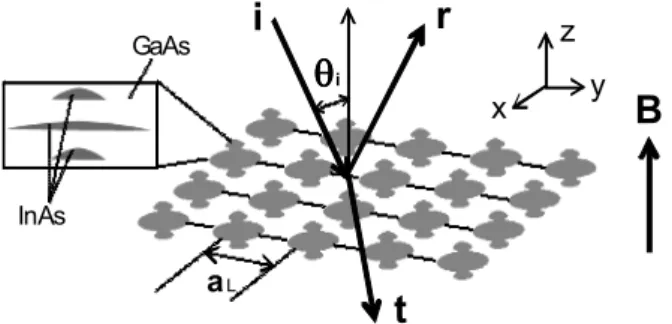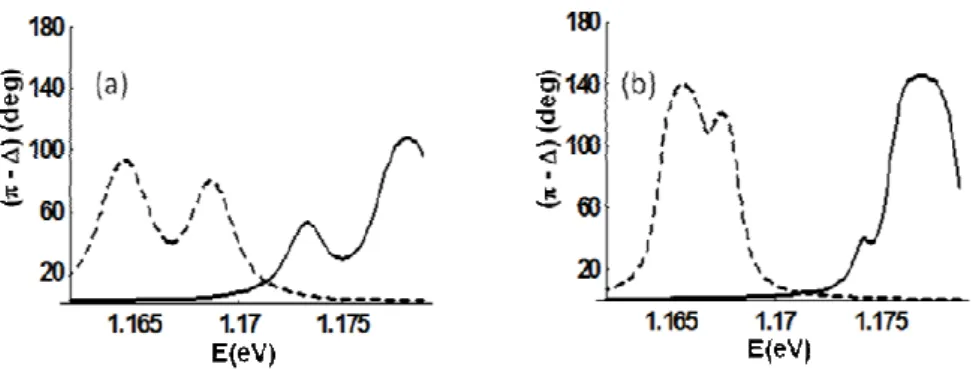行政院國家科學委員會專題研究計畫期中(第三年)報告 奈米結構合成材料的磁光效應
奈米結構合成材料的磁光效應奈米結構合成材料的磁光效應 奈米結構合成材料的磁光效應
Magneto-Optics of Nano-Stuctured Composite Materials 計畫編號:
96-2112-M-009-009-
執行期限:96年08月1日至 97年7月31日
主持人:霍斯科 (O.Voskoboynikov) 教授 交通大學電子工程系暨電子研究 一 摘要 (Abstract )
英文
This report summarizes the major results obtained from the third year program of the ”Magneto-Optics of Nano-Stuctured Composite Materials” project. Two directions of research have been pursued, as described in detail in the report: #1 Problems of connection between quantum mechanical states in semiconductor quantum dot molecules and the magneto-optical response of embedded layers of those semiconductor nano-objects; #2 Unusual diamagnetic properties of asymmetrical semiconductor quantum dot molecules. Several publications were performed based on this year’s results.
中文 這份報告總結了三年來在“奈米結構合成材料的磁光效應”計畫中的主要成果。研究方向如同 下列兩個報告所詳述:#1覆蓋層與結構表面對半導體奈米深埋層的光響應之影響#2在垂直堆 疊的雙層銦化鎵/砷化鎵不對稱量子點的磁響應的動態控制,此外我們實現了一個有趣的可 能,藉由微型半導體奈米原件的自旋軌域相互作用可以驅使動態磁化與靜態磁化率。基於今 年的研究已經發表了數個論文。
二 Connection between quantum mechanical states in semiconductor quantum dot molecules and the magneto-optical response of embedded layers of this semiconductor nano-objects Recently we have derived a hybrid discrete-continuum model to investigate the changes in optical response of systems of nano-objects (quantum dots or nano-rings) upon embedding. The behavior of this model can be understood in terms of field penetration and excess susceptibility. These mechanisms determine what happens when the nano-objects get embedded in a dielectric host material. All electromagnetic interactions in a nonlocal picture however turn out to be screened by the host dielectric constant.
In our theory we propose a method which allows to monitor the coherent manipulation of the electronic states in the embedded semiconductor objects (self-assembled quantum dots, nano-rings, and quantum molecules made from them) by means of traditional ellipsometry. On the base of our multi-scale hybrid discrete-continuum description the optical response of layers of nano-objects has been determined. In the hybrid description each nano-object is represented by a single discrete dipole and characterized by a bare excess polarizability. This polarizability consists of a static part, determined electromagnetically, and a dynamical part (including energies and probabilities of the optical transitions in the object), determined quantum mechanically. From the electromagnetic interactions inside and between the objects (dipoles) the full internal optical response (reflection, transmission) is obtained in a very direct manner.
We demonstrate the method using as an example the lattice plane of InAs double (Fig. 1) and triple (Fig.2) quantum dot molecules embedded in GaAs matrix. The external magnetic field B is applied along the system growth direction. First we calculate electronic energy states for a system of two vertical circular InAs/GaAs quantum dots for a realistic three-dimensional model of the dots with a hard-wall confinement potential. Our quantum dots have substantially different diameters in contrast to most of the known simulations. We demonstrated that the coupled electronic ground
states can be coherently driven by the external magnetic field: we are able to relocate electronic wave functions from one dot to another (Fig. 3). The change in the electronic states leads to the redistribution of the intensity of the reflectance and absorbance peaks in the collective magneto-optical response of the layer of quantum dot molecules (see Fig.4 and Fig. 5). Varying the distance between quantum dots within the molecule one can study optically the transition from "molecular" to "atomic" configuration of the nano-objects. We have shown that the changes in the quantum mechanical behaviour of the molecules can be made observable by monitoring changes of the ellipsometric parameters Ψ and ∆ in the magneto-optical response of layers of such nano-objects. The calculation results clearly suggest measurable values for the ellipsometric angles for any modern ellipsometric setup. We emphasize that the magneto-ellipsometric data reproduce important information on the quantum mechanics of the molecules. The method can be potentially useful for the design and characterization of new nano-structured semiconductor meta-materials and in the field of quantum information.
三 三 三
三 Unusual diamagnetic properties of asymmetrical semiconductor quantum dot molecules Pairs of high-quality coupled semiconductor quantum dots [quantum dot molecules (QDM)] were proposed recently to manipulate electronic states by variation of the distance between the dots (static coherent tuning) or by variation of the external fields (dynamic coherent tuning). A vast amount of literature discusses the magnetic phenomena in terms of spin magnetism in quantum dots However, under certain conditions the diamagnetism can be even more important and very un usual in semiconductor nano-objects. For instance, semiconductor nano-rings are doubly (non-simply) connected objects. When the external magnetic field B is in the system growth direction, the center hole enables oscillations of the magnetization (the Aharonov-Bohm effect) and a positive peak in the differential magnetic susceptibility (DMS) of the system with a single electron confined in the nano-ring.
In this study we have shown that DMS a single electron vertical QDM also can demonstrate a positive peak if the incorporated dots have substantially different radial dimensions and the external magnetic field B is in the system growth direction. The important difference from nano-rings is that the molecule is a totally separated geometrical object (see insert to Fig. 6 (a)).
Considering static magnetic response we studied a system of two vertical lens-shaped circular InAs/GaAs quantum dots. The quantum dots have substantially different diameters in contrast to most of the investigated structures. To demonstrate the feasibility of the unusual diamagnetic response in the asymmetrical QDM we use realistic semiconductor material parameters for InAs/GaAs QDM (as an example). The energy states and wave functions of the electrons confined in the quantum dot molecule are found by the nonlinear iterative method developed by us using the Comsol Multiphysics package (www.comsol.com).
We demonstrate theoretically a possibility to relocate the ground state electronic wave function from one dot to another by applying an external magnetic field along the structures growth direction (Fig. 7). The relocation correlates with the anti-crossing behavior of the two lowest electronic states of the quantum dot molecule (Fig. 6(b)). This effect originates from non-uniform diamagnetic shift for electronic states located in different dots and generates unusual features of the magnetization and magnetic susceptibility of the system. At low temperature, the differential susceptibility of the system has a positive peak (Fig. 7). With temperature increasing the peak gradually disappears. Our calculation results demonstrate that specifically III-V semiconductor quantum dot systems can be designed to observe the effect. The geometry is crucial for such investigations and should be properly tuned and controlled. It follows form this theoretical study that experimental investigation of the magnetic properties of asymmetrical semiconductor quantum dot molecules will yield interesting results and can be useful for further fabrication of materials with principally new magnetic properties.
Publications:
1. C.M.J. Wijers, J-H. Chu and O. Voskoboynikov, "Electrostatic Response of Embedded Oblate Spheroidal Nano-objects", submitted to Journal of Electrostatics (2007), (SCI) 2. O. Voskoboynikov, “Unusual diamagnetism in vertical asymmetrical quantum dot
molecule”, submitted to Physical Review B (2008). (SCI)
3. Thu Le Minh and O. Voskoboynikov, "Magneto-optics of layers of triple quantum dot molecules", accepted to physica status solidi C (2008). (SCI)
4. 4. Leo Yu and O. Voskoboynikov, "Ballistic Aharonov-Bohm quantum bits and quantum gates", Solid State Communications, vol. 145, no. 1, pp. 447-450, Dec. 2008 (SCI).
5. C.M.J. Wijers and O. Voskoboynikov, "Optical reflection from a monolayer of embedded nano-objects covered by a thick capping layer", Periodical Book: Advanced Material Research, Vol. 31 ,pp. 52-55, Dec. 2008.
6. 5. C. M. J. Wijers and O. Voskobyonikov, “Magneto-optical response of layers of quantum dot molecules”, Book: Proceedings of the First International Congress on Advanced Electromagnetic Materials in Microwaves and Optics, Italy, Rome, pp.334-337, Nov. 2007. 7. Thu Le Minh and O. Voskoboynikov, "Magneto-optics of layers of triple quantum dot
molecules", The 5th International Conference on Semiconductor Quantum Dots (QD2008) in Gyeongju, Korea, May (2008).
8. O.Voskoboynikov, "Simulation of static magnetic response of an asymmetrical quantum dot molecule", oral presentation at the Symposium on Mathematical and Computational Nanoscience, Wellington, New Zealand, Dec. (2007).
9. C. M. J. Wijers and O. Voskobyonikov*, “Magneto-optical response of layers of quantum dot molecules”, presentation at the First International Congress on Advanced Electromagnetic Materials in Microwaves and Optics, Rome, Italy, Oct. (2007).
10. O. Voskoboynikov* and C. M. J. Wijers, "Magnetization of coupled quantum dots manifesting a magnetic qubit", oral presentation at the International Conference on Materials for Advanced Technologies 2007, Singapore, July (2007).
11. C.M.J. Wijers* and O. Voskoboynikov, "Optical reflection from Magneto-optical response of layers of quantum dot molecules", oral presentation at the International Conference on Materials for Advanced Technologies 2007, Singapore, July (2007)
Figures:
i
r
t
z
θ
θ
θ
θ
i x y zB
Fig. 1. Layer of embedded double dot molecules.
i
r
z y xt
B
a L InAs GaAsθ
θ
θ
θ
iFig. 2. Schematic of magneto-optical response from a layer of triple quantum dot molecules.
Fig. 3. Wave function's evolution in magnetic field for the lowest three electron's energy levels and one hole level in a triple quantum dot molecule. The bottom graph is sketching the dots geometry in
Fig.4. Magnetic field dependence of the ellipsometric angles for the layer of triple QDM: (a) inter dot distance d = 10 nm; (b) inter-dot distance d = 12 nm. Dashed curve: B = 0 T; Solid
curve: B = 20 T.
Fig. 5 Magnetic field dependence of the absorbance peaks for the layer of double quantum dot molecules (top view). Distance between dots in the layer: d = 10 nm.
Fig. 6. Electron energy states of asymmetrical QDM as functions on the external magnetic field: (a) 14 lowest states, in insert - asymmetrical InAs/GaAs QDM in the external magnetic field B;
Fig. 7. Electronic wave functions in the asymmetrical QDM: (a) QDM projection onto radial plane; (b) Transformation of the lowest electron energy state wave functions near the anticrossing point.
Fig.8. Differential magnetic susceptibility of InAs/GaAs double dot molecule system inter-dot distance d = 20 nm.


